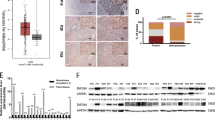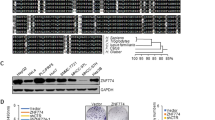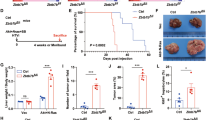Abstract
To achieve a better understanding of mechanisms that underlie hepatocarcinogenesis and to identify novel target molecules for diagnosis and therapy of hepatocellular carcinoma (HCC), we previously analysed gene-expression profiles of 20 HCC tissues on a cDNA microarray. Among the genes upregulated in the tumor tissues compared with their nontumor counterparts, we focused on a novel gene termed transcription-involved protein upregulated in HCC (TIPUH1) that putatively encoded a 500-amino-acid protein containing 12 zinc-finger domains and a Kruppel-associated box domain. Multiple-tissue northern blot analysis revealed it's testis- and placenta-specific expression in normal tissues. Colony-formation assay in soft agar showed that TIPUH1 conferred anchorage-independent growth to NIH3T3 cells, suggesting its oncogenic activity. Conversely, specific siRNA for TIPUH1 knocked down its expression in HCC cells, which resulted in their growth inhibition. We identified four TIPUH1-interacting proteins including TIF1β, a transcription-intermediary protein, and three involved in pre-mRNA processing (hnRNPU, hnRNPF, and Nucleolin), suggesting that overexpressed TIPUH1 may play a role in hepatocarcinogenesis by regulating transcription and/or RNA processing of growth control genes. These data may contribute to a better understanding of liver neoplasia, and to the development of novel strategy for treatment of HCCs.
This is a preview of subscription content, access via your institution
Access options
Subscribe to this journal
Receive 50 print issues and online access
$259.00 per year
only $5.18 per issue
Buy this article
- Purchase on Springer Link
- Instant access to full article PDF
Prices may be subject to local taxes which are calculated during checkout




Similar content being viewed by others
Accession codes
References
Caceres JF, Kornblihtt AR . (2002). Trends Genet 18: 186–193.
Collins T, Stone JR, Williams AJ . (2001). Mol Cell Biol 11: 3609–3615.
Feitelson MA, Sun B, Satiroglu Tufan NL, Liu J, Pan J, Lian Z . (2002). Oncogene 21: 2593–2604.
Ford LP, Wright WE, Shay JW . (2002). Oncogene 21: 580–583.
Grisham JW (ed). (2001). The Molecular Basis of Human Cancer. Humana Press: Totowa, pp. 269–346.
Hamamoto R, Furukawa Y, Morita M, Iimura Y, Silva FP, Li M et al. (2004). Nat Cell Biol 6: 731–740.
Howell M, Borchers C, Milgram SL . (2000). J Biol Chem 279: 26300–26306.
Kim GJ, Cho SJ, Won NH, Sung JM, Kim H, Chun YH et al. (2003). Cancer Genet Cytogenet 142: 129–133.
Looman C, Abrink M, Mark C, Hellman L . (2002). Mol Biol Evol 19: 2118–2130.
Mark C, Abrink M, Hellman L . (1999). DNA Cell Biol 18: 381–396.
Nielsen AL, Ortiz JA, You J, Oulad-Abdelghani M, Khechumian R, Gansmuller A et al. (1999). EMBO J 18: 6385–6395.
Oguri T, Katoh O, Takahashi T, Isobe T, Kuramoto K, Hirata S et al. (1998). Gene 222: 61–67.
Okabe H, Satoh S, Kato T, Hasegawa S, Nakajima Y, Yamaoka Y et al. (2001). Cancer Res 61: 2129–2137.
Parkin DM, Bray FI, Devesa SS . (2001). Eur J Cancer 37 (Suppl 8): S4–S66.
Raidl M, Pirker C, Schulte-Hermann R, Aubele M, Kandioler-Eckersberger D, Wrba F et al. (2004). J Hepatol 40: 660–668.
Reed R, Magni K . (2001). Nat Cell Biol 3: 201–204.
Satoh S, Daigo Y, Furukawa Y, Kato T, Miwa N, Nishiwaki T et al. (2000). Nat Genet 24: 245–250.
Schultz DC, Friedman JR, Rauscher III FJ . (2001). Genes Dev 15: 428–443.
Shimokawa T, Furukawa Y, Sakai M, Li M, Miwa N, Lin YM et al. (2003). Cancer Res 63: 6116–6120.
Silva FP, Hamamoto R, Furukawa Y, Nakamura Y . (2005). Neoplasia 7: 348–355.
Tanaka S, Toh Y, Adachi E, Matsumata T, Mori R, Sugimachi K . (1993). Cancer Res 53: 2884–2887.
Underhill C, Qutob MS, Yee SP, Torchia J . (2000). J Biol Chem 275: 40463–40470.
Urrutia R . (2003). Genome Biol 4: 231.
Wilkens L, Bredt M, Flemming P, Becker T, Klempnauer J, Kreipe HH . (2001). J Pathol 193: 476–482.
Witzgall R, O'Leary E, Leaf A, Onaldi D, Bonventre JV . (1994). Proc Natl Acad Sci USA 91: 4514–4518.
Acknowledgements
We are grateful to Ms Yuka Yamane for excellent technical assistance. This work was supported in part by Research for the Future Program Grant (00L01402) from the Japan Society for the Promotion of Science.
Author information
Authors and Affiliations
Corresponding author
Rights and permissions
About this article
Cite this article
Silva, F., Hamamoto, R., Furukawa, Y. et al. TIPUH1 encodes a novel KRAB zinc-finger protein highly expressed in human hepatocellular carcinomas. Oncogene 25, 5063–5070 (2006). https://doi.org/10.1038/sj.onc.1209517
Received:
Revised:
Accepted:
Published:
Issue Date:
DOI: https://doi.org/10.1038/sj.onc.1209517
Keywords
This article is cited by
-
Clinical Utility of KAP-1 Expression in Thyroid Lesions
Endocrine Pathology (2013)



